Ivy is a well-known plant that is commonly found growing on brick walls or trellises near classic homes.
Even though it has been popular in gardening for many years, the variety of cultivars and easy care have kept it a popular plant.
The good news for houseplant lovers is that ivy will also do well indoors when given the proper care.
How To Grow Ivy Indoors
By providing the right environment and resources for an ivy plant, you will have a healthy, thriving plant.
Ivy makes a great addition to the home because it has beautiful foliage and can create long, trailing vines.
1. Provide Ample Lighting
The most important factor for growing ivy indoors is the amount of light it receives. Most ivy varieties require bright, indirect light.
Some variegated varieties of ivy do not require as much light, and they will do best in medium light conditions.
If insufficient light is provided to the plant, ivy can become leggy and produce small leaves. Overall, the plant will become sickly and dull.
Low light can also cause variegated varieties to revert back to green leaves.
The extra chlorophyll is necessary because more photosynthesis will need to take place with the absence of proper lighting.
2. Maintain a Watering Schedule
Ivy plants do not like a lot of water and tend to do better when the soil is on the drier side. Before watering, always check the soil of the plant.
Only water when the top few inches of soil are dry.
Make sure that the pot for the ivy has drainage holes. Standing water in the soil is not good for the health of the roots.
Occasionally, it is helpful to water the ivy plant by spraying it down in the shower (or with sprayer attachment in the sink). This helps to remove dust and debris from all the leaves.
3. Increase Humidity as Needed
Even though ivy plants don’t enjoy wet soil, they do like a humid environment. If you need to add humidity for your plant, there are a few options:
- House multiple plants near each other
- Run a humidifier
- Place a pebble tray with water under the plant
Avoid misting the plant, unless that is your only option to increase humidity.
Since ivy plants have lots of leaves, water on the leaves can sit for extended periods, increasing the opportunity for infections to take hold.
4. Fertilize During the Growing Season
With great care, most ivy plants can grow quickly and turn into large, trailing vines. All that growing requires lots of nutrients.
Use a nitrogen-rich fertilizer, like this slow-release food, once a month during the growing season (spring and summer for most locations).
Nitrogen is important for plants like ivy, which produce a lot of foliage.
Do not fertilize in the winter months because most ivy plants go dormant or slow down growth.
Adding fertilizer during this time can actually cause harm to the plant in the form of fertilizer burn.
5. Prune Your Ivy Regularly
Ivy plants are known for being fast or extremely fast growers, depending on the variety.
Since the vines can grow to be over 10 feet long on most cultivars, it is important to keep the plant pruned to a desirable size.
Always use sterilized scissors or garden shears when trimming the vines.
While the main reason to prune your ivy plant is for aesthetics, it is also for the good of your home and furniture.
Depending on the type of ivy, the plants use rootlets or chemical compounds to adhere themselves to anything for climbing support.
Over time the rootlets or compounds can cause irreversible damage to your furniture or walls.
35 Ivy Varieties To Grow Indoors
There are hundreds of true ivies and false ivies to choose from. Almost every variety is able to be grown indoors under the proper conditions.
However, these 35 varieties are species that have been proven to thrive when grown indoors.
#1 English Ivy
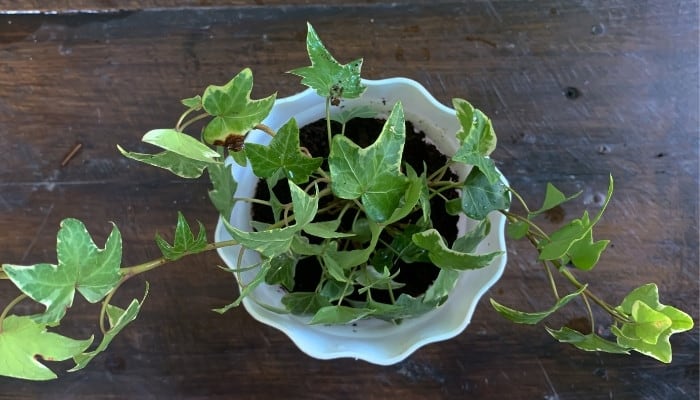
English ivy is the most common ivy plant seen in gardens and as a houseplant. This is the parent species for many popular cultivars.
The settlers of the colonies brought English ivy to the (now) United States in the 1700s.
- Botanical Name: Hedera helix
- Lighting Needs: Bright, indirect light
- Growth Rate: Fast
- Key Feature: Green pointed leaves with light veins
#2 Japanese Ivy
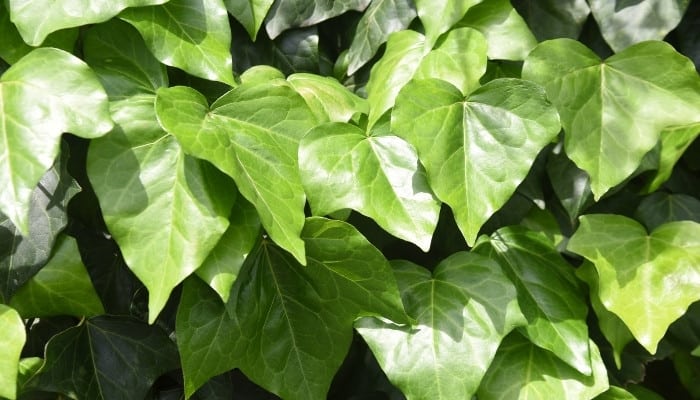
Japanese ivy is considered a “small” ivy plant because it does not grow as extensively as other varieties.
This does not make much of a difference when the plant is grown indoors because it will never reach its full length.
The leaves are oblong and pointed, and they do not have multiple lobes.
- Botanical Name: Hedera rhombea
- Lighting Needs: Bright, indirect light
- Growth Rate: Fast
- Key Feature: Climbing ability
#3 Persian Ivy
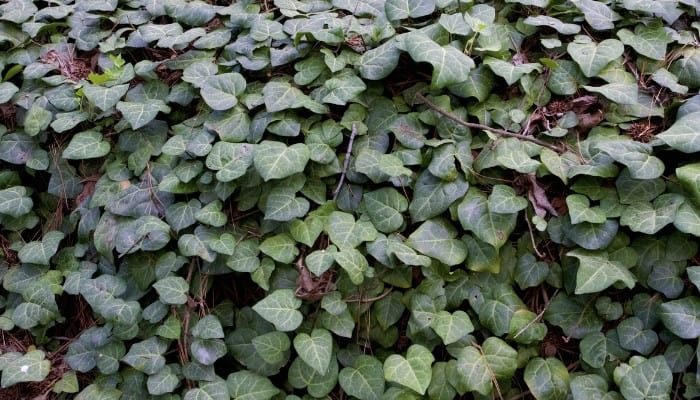
Persian ivy originated in Turkey. It is capable of extremely rapid growth and is a strong climber.
This plant puts out small rootlets to grip climbing structures and can cause damage to walls or furniture if it grabs hold.
- Botanical Name: Hedera colchica
- Lighting Needs: Bright, indirect light
- Growth Rate: Very fast
- Key Feature: Adaptable to many growing conditions
#4 Irish Ivy
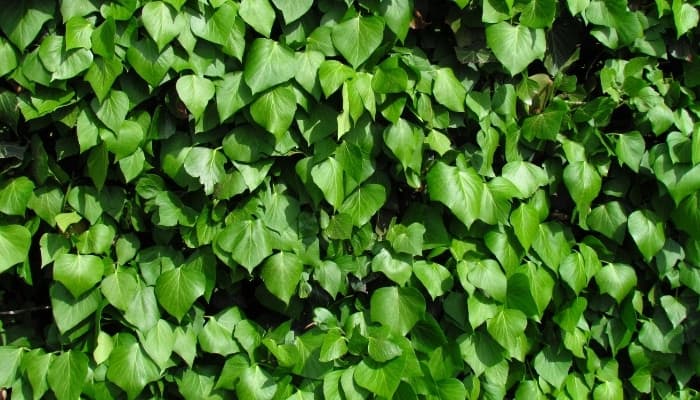
Irish ivy is another excellent climbing variety of ivy. This plant differs from English ivy with broader leaves and less light coloration around the veins.
Even indoors, it can produce white flowers in the summer.
- Botanical Name: Hedera hibernica
- Lighting Needs: Bright, indirect light
- Growth Rate: Fast
- Key Feature: Broad, dark-green leaves
#5 Russian Ivy
Russian ivy is native to Western Asia and gets its name from the previous USSR control of the area.
This plant is different from more well-known ivy varieties because it does not have multiple lobes on its leaves.
- Botanical Name: Hedera pastuchovii
- Lighting Needs: Bright, indirect light
- Growth Rate: Medium to fast
- Key Feature: Elongated leaves without lobes
#6 Algerian Ivy
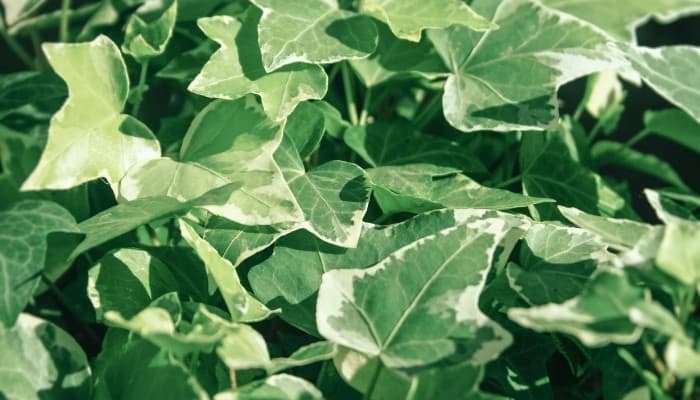
The most common cultivars of Algerian ivy are variegated with beautiful cream edges, although in the wild most Algerian ivy has solid green leaves.
This is a gorgeous and affordable plant to add to your houseplant collection.
- Botanical Name: Hedera algeriensis
- Lighting Needs: Bright, indirect light
- Growth Rate: Medium to fast
- Key Feature: Broad leaves (usually variegated)
#7 Nepal Ivy
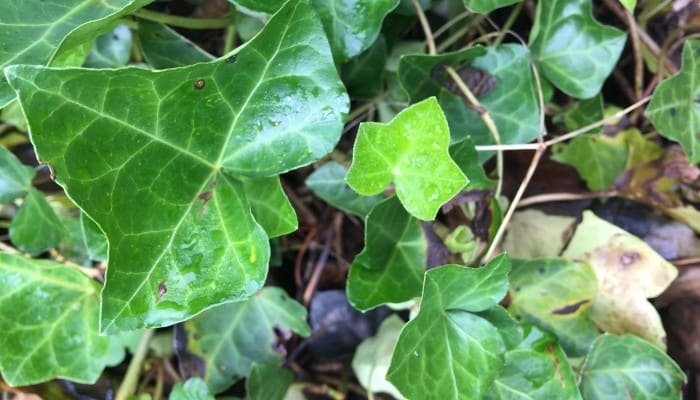
Nepal ivy or Himalayan ivy looks very similar to English ivy. It is easy to care for and is more shade tolerant than other species of ivy.
It can survive in low-light conditions, but it will do best in medium to bright indirect light.
- Botanical Name: Hedera nepalensis
- Lighting Needs: Bright, indirect to medium light
- Growth Rate: Medium
- Key Feature: Easy to care for
#8 Swedish Ivy
Swedish ivy is not related to most ivy species, but it is a fast-growing vine. The leaves look nothing like other ivy species; they are round with wavy edges.
There are cultivars with all green leaves and cultivars with white variegation around the edges of the leaves.
- Botanical Name: Plectranthus australis
- Lighting Needs: Bright, indirect light
- Growth Rate: Fast
- Key Feature: Round leaves with wavy edges
#9 Glacier Ivy
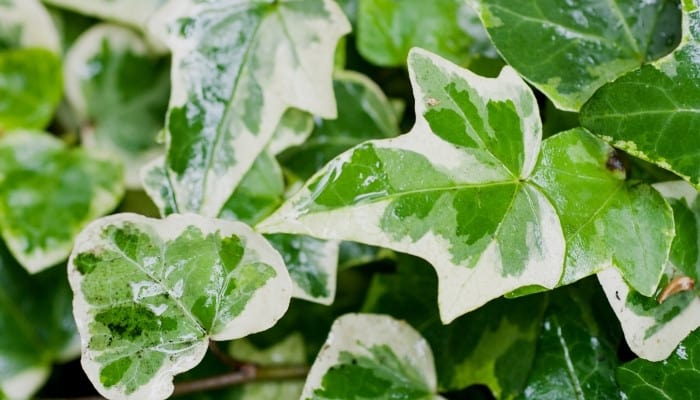
Glacier ivy is a cultivar of English ivy. It looks identical to English ivy, except it has cream-colored variegation.
These beautiful leaves grow on long trailing vines that look great in a hanging basket.
- Botanical Name: Hedera helix ‘Glacier’
- Lighting Needs: Bright, indirect light
- Growth Rate: Fast
- Key Feature: Cream-colored variegation
#10 Needlepoint Ivy
Needlepoint ivy is a cultivar of English ivy that features thin lobes on the leaves. It is fairly drought tolerant, which makes it an excellent variety for a beginner.
Thanks to the unique leaves, Needlepoint ivy looks great in any container and will spill out the sides.
- Botanical Name: Hedera helix ‘Needlepoint’
- Lighting Needs: Bright, indirect light to low light
- Growth Rate: Medium
- Key Feature: Slender lobes on leaves
#11 Goldchild Ivy
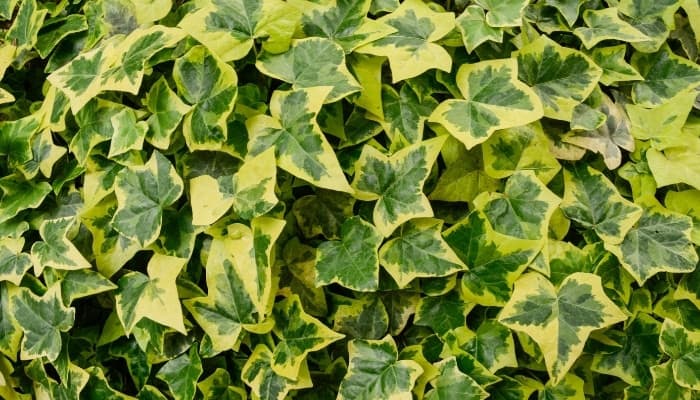
Goldchild ivy is a cultivar of English ivy that features golden variegation. Depending on the amount of sunlight the plant receives, the leaves can be light to dark yellow in color.
The vines will need some pruning to maintain the shape, but overall this is a smaller variety than most ivy plants.
- Botanical Name: Hedera helix ‘Goldchild’
- Lighting Needs: Bright, indirect light
- Growth Rate: Fast
- Key Feature: Small size when mature
#12 Buttercup Ivy
Buttercup ivy is similar to Goldchild ivy, except the leaves have a uniform yellow color. This variety can handle some direct sunlight, but it should be the less severe morning sun.
The color of the leaves will depend on the amount of light the plant receives, with more sun deepening the yellow color.
- Botanical Name: Hedera helix ‘Buttercup’
- Lighting Needs: Medium to bright, indirect light
- Growth Rate: Fast
- Key Feature: Yellow leaves in full sun
#13 Adam Ivy
Adam ivy has small leaves that have beautiful white-and-silver variegation. Adam ivy is a great climber, but it looks beautiful and bushy when allowed to spill out of a container.
- Botanical Name: Hedera helix ‘Adam’
- Lighting Needs: Bright, indirect light
- Growth Rate: Fast
- Key Feature: White and silver variegated leaves
#14 Bettina Ivy
While Bettina ivy is a trailing vine, it is not an aggressive grower like other English ivy cultivars.
This makes a great desk plant because the vines can be trimmed to an attractive, bushy shape. The leaves of Bettina ivy are light green with thin white or cream-colored borders.
- Botanical Name: Hedera helix ‘Bettina’
- Lighting Needs: Bright, indirect light
- Growth Rate: Medium
- Key Feature: Thin, white borders on leaves
#15 Angel Snow Ivy
Angel Snow ivy has distinct leaves that look like a light dusting of snow. The mottled white-and-green coloration makes this a stunning house plant cultivar.
This plant is also fairly compact, so it can easily be kept on a tabletop without spilling over too much.
- Botanical Name: Hedera helix ‘Angel Snow’
- Lighting Needs: Bright, indirect light
- Growth Rate: Medium
- Key Feature: Mottled green and white coloration
#16 Florida Ivy
Florida ivy is a versatile variety that will do well in many locations. It prefers bright, indirect light but it can tolerate lower light levels.
However, the color of the leaves changes from light green to dark green depending on the amount of light.
- Botanical Name: Hedera helix ‘Florida’
- Lighting Needs: Bright, indirect light
- Growth Rate: Medium
- Key Feature: Distinct, pointed lobes
#17 Aloma Ivy
Aloma ivy is another cultivar of English ivy that is great for indoor use. It is a trailing vine like all ivy, but with proper pruning, it has an attractive, bushy appearance.
Young leaves are light green in color and obtain a silver border as they mature.
- Botanical Name: Hedera helix ‘Aloma’
- Lighting Needs: Bright, indirect light
- Growth Rate: Fast
- Key Feature: Silver borders on leaves
#18 Duckfoot Ivy
Duckfoot ivy is named for its unique appearance. The lobes of the leaves are rounded and blend together, which gives each leaf a shape that is similar to a duck’s foot.
This plant is easy going and can handle a variety of lighting conditions.
- Botanical Name: Hedera helix ‘Duckfoot’
- Lighting Needs: Bright, indirect light
- Growth Rate: Fast
- Key Feature: Rounded lobes that look like a duck’s foot
#19 Manda’s Crested Ivy
Manda’s Crested ivy is a cultivar of English ivy that has large, curly leaves. Even when allowed to trail or climb, the curly leaves give the appearance of full, bushy foliage.
- Botanical Name: Hedera helix ‘Manda’s Crested’
- Lighting Needs: Bright, indirect light
- Growth Rate: Fast
- Key Feature: Large, curly leaves
#20 Asterisks Ivy
Asterisks ivy gets its name from the shape of the leaves, which look like large asterisks. The leaves start off a lighter green and darken as they mature.
The large, distinct leaves make an attractive addition to the home.
- Botanical Name: Hedera helix ‘Asterisk’
- Lighting Needs: Bright, indirect light
- Growth Rate: Fast
- Key Feature: Asterisk-shaped leaves
#21 Gloire de Marengo Ivy
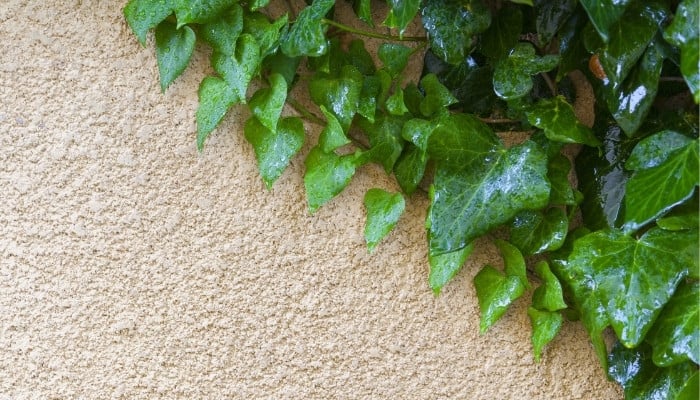
Gloire de Marengo ivy is a variegated cultivar of Algerian ivy. The leaves feature dark green and gray-green variegation with irregular cream-colored edges.
The leaves typically do not have distinct lobes and have a heart shape.
- Botanical Name: Hedera algeriensis ‘Gloire de Marengo’
- Lighting Needs: Bright, indirect light
- Growth Rate: Medium to fast
- Key Feature: Beautiful variegation on broad leaves
#22 Sulfur Heart Ivy
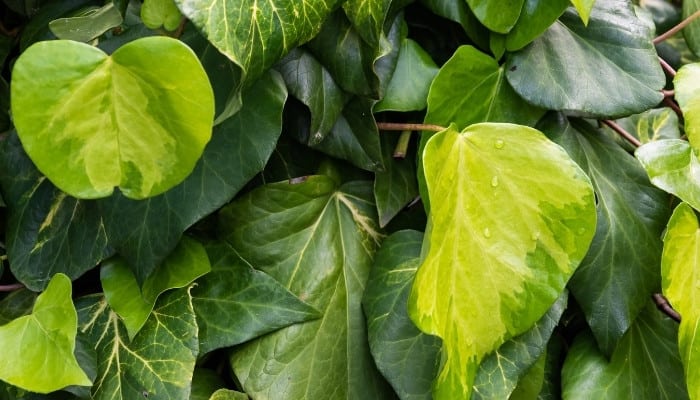
Sulphur Heart ivy is a cultivar of Persian ivy. It looks very similar to Persian ivy, except the center of the leaf is yellowish green (the “sulphur” heart).
The broad, uniquely-colored leaves look great when given the opportunity to spill out of a container.
- Botanical Name: Hedera colchica ‘Sulphur Heart’
- Lighting Needs: Bright, indirect light
- Growth Rate: Very fast
- Key Feature: Yellow center on leaves
#23 Shamrock Ivy
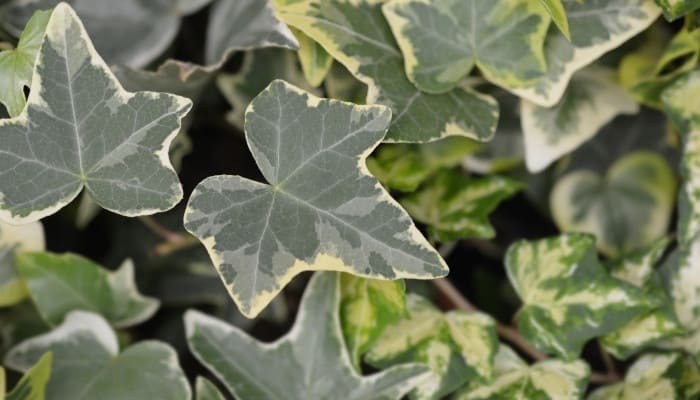
Shamrock ivy gets its name because every leaf has three lobes. The two smaller lobes tend to slightly overlap the larger lobe.
This is a cultivar of English ivy and it is very easy to grow. It prefers bright, indirect light, but it can handle lower light conditions when necessary.
- Botanical Name: Hedera helix ‘Shamrock’
- Lighting Needs: Bright, indirect light
- Growth Rate: Fast
- Key Feature: Three distinct lobes on leaves
#24 Ivalace Ivy
While most plants have a watering imbalance when their leaves curl, Ivalace ivy has leaves that naturally curl.
The fun texture gives this English ivy cultivar a unique and scratchy look. This variety of ivy is a great climber that can be trained into different shapes on a trellis or as a topiary.
- Botanical Name: Hedera helix ‘Ivalace’
- Lighting Needs: Medium light
- Growth Rate: Medium to fast
- Key Feature: Leaves curl at the edges
#25 Chicago Ivy
Chicago ivy has some of the darkest colored leaves of all ivy varieties.
The triangular leaves are typically flat, but it is not uncommon for them to fold or slightly curl around the edges.
Outdoors, this plant is usually found on the sides of buildings as it is an excellent climber.
- Botanical Name: Hedera helix ‘Chicago’
- Lighting Needs: Bright, indirect light
- Growth Rate: Fast
- Key Feature: Large, deep-green leaves
#26 Gold Baby Ivy
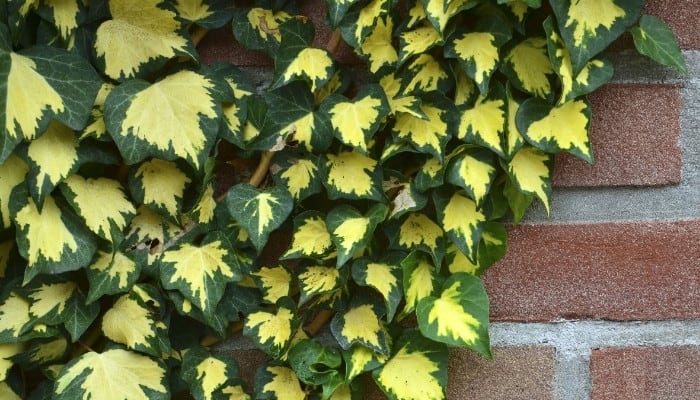
Gold Baby ivy is a cultivar of English ivy. This plant is smaller than most, although it is still a trailing vine that will need to be pruned to maintain the shape.
The main feature of Gold Baby ivy is the small green leaves that have a golden colored border.
- Botanical Name: Hedera helix ‘Gold Baby’
- Lighting Needs: Bright, indirect light
- Growth Rate: Medium
- Key Feature: Small leaves with golden edges
#27 Francis Ivy
Francis ivy has broad leaves with multiple lobes. The lobes tend to have a slight wave in their shape.
Francis ivy is a cultivar of English ivy that grows upright before elongating into vines.
- Botanical Name: Hedera helix ‘Francis’
- Lighting Needs: Bright, indirect light
- Growth Rate: Fast
- Key Feature: Grows upright instead of vining
#28 Big Shot Ivy
Big Shot ivy is a cultivar of English ivy. It has large, heart-shaped leaves with an attractive mottled blend of cream and green.
The visual impact of Big Shot ivy is impressive, and this plant will make a statement in your home.
- Botanical Name: Hedera helix ‘Big Shot”
- Lighting Needs: Bright, indirect light
- Growth Rate: Fast
- Key Feature: New growth has cream-colored freckles
#29 Curly Locks Ivy
Curly Locks ivy is a beautiful cultivar of English ivy that has leaves with multiple lobes.
Each lobe tends to curl in a different direction, giving the plant a fun, ruffled appearance.
- Botanical Name: Hedera helix ‘Curly Locks’
- Lighting Needs: Bright, indirect light
- Growth Rate: Fast
- Key Feature: Bright green, curly leaves
#30 Canarian Ivy
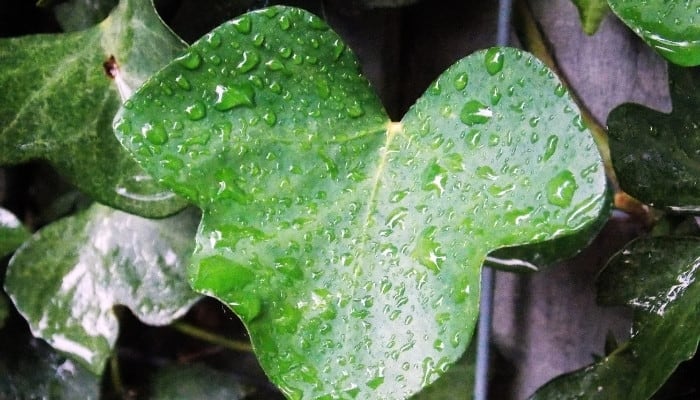
The Canarian ivy is native to the Canary Islands off of Africa. It is often misidentified as the Algerian ivy, which lives in the same area.
The large, broad leaves of Canarian ivy will cover a lot of space, leading to a full-looking plant.
- Botanical Name: Hedera canariensis
- Lighting Needs: Bright, indirect light
- Growth Rate: Very fast
- Key Feature: Large, broad leaves
#31 Fluffy Ruffles Ivy
Fluffy Ruffles ivy probably has the most unique name and look of any ivy plant. The edges of the leaves are so ruffled, it can be hard to identify where the lobes are.
The undersides and edges of the leaves have a pink tint.
- Botanical Name: Hedera helix ‘Fluffy Ruffles’
- Lighting Needs: Bright, indirect light
- Growth Rate: Fast
- Key Feature: Intensely curly leaves
#32 Gold Dust Ivy
Gold Dust ivy is another cultivar of English ivy. This variety has dark green leaves that are splashed with gold-colored mottling.
The lobes of the leaves blend together into a heart shape.
- Botanical Name: Hedera helix ‘Gold Dust’
- Lighting Needs: Bright, indirect light
- Growth Rate: Fast
- Key Feature: Yellow mottling on the leaves
#33 Primadonna Ivy
Primadonna ivy has heart-shaped leaves that usually have three lobes. The variegation can be anywhere from a few splotches of white on the leaves to mostly white leaves.
Make sure Primadonna ivy has plenty of bright light to maintain beautiful variegation.
- Botanical Name: Hedera helix ‘Primadonna’
- Lighting Needs: Bright, indirect light
- Growth Rate: Fast
- Key Feature: White variegation on the leaves
#34 Royal Hustler Ivy
The lobes on Royal Hustler ivy are almost nonexistent, leaving the plant with heart-shaped or rounded leaves.
The leaves are an intense dark color that looks striking against a light-colored background. This is an easy-to-care-for plant that can handle a short period of neglect.
- Botanical Name: Hedera helix ‘Royal Hustler’
- Lighting Needs: Medium light
- Growth Rate: Medium
- Key Feature: Heart-shaped or rounded dark-green leaves
#35 Jubilee Ivy
Jubilee ivy is a smaller cultiver of English ivy. The dull green leaves have small sections of cream-colored variegation.
The small size of the plant and small leaves make this a great option for table tops or desks.
- Botanical Name: Hedera helix ‘Jubilee’
- Lighting Needs: Bright, indirect light
- Growth Rate: Fast
- Key Feature: Small leaves with cream-colored variegation

![These 35 Ivy Plants Grow Great Indoors [+ How To Grow Them]](https://whyfarmit.com/wp-content/uploads/2021/09/Potted-English-ivy-on-small-brown-table.jpg)